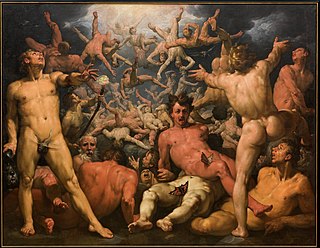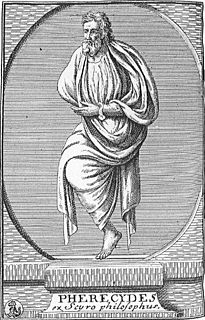Related Research Articles

In Greek mythology, the Titans were the pre-Olympian gods. According to the Theogony of Hesiod, they were the twelve children of the primordial parents Uranus (Sky) and his mother, Gaia (Earth), with six male Titans: Oceanus, Coeus, Crius, Hyperion, Iapetus, and Cronus, and six female Titans, called the Titanides : Theia, Rhea, Themis, Mnemosyne, Phoebe, and Tethys. Cronus mated with his older sister Rhea and together they became the parents of the first generation of Olympians: Zeus and his five siblings Hestia, Demeter, Hera, Hades and Poseidon. Descendants of the Titans are sometimes also called Titans.

In Greek mythology, Tartarus is the deep abyss that is used as a dungeon of torment and suffering for the wicked and as the prison for the Titans. Tartarus is the place where, according to Plato's Gorgias, souls are judged after death and where the wicked received divine punishment. Tartarus is also considered to be a primordial force or deity alongside entities such as the Earth, Night and Time.
In Greek mythology and Roman mythology, a harpy is a half-human and half-bird personification of storm winds. They feature in Homeric poems.

Tezcatlipoca was a central deity in Aztec religion, and his main festival was the Toxcatl ceremony celebrated in the month of May. One of the four sons of Ometecuhtli and Omecihuatl, he is associated with a wide range of concepts, including the night sky, the night winds, hurricanes, the north, the earth, obsidian, enmity, discord, rulership, divination, temptation, jaguars, sorcery, beauty, war and strife. His name in the Nahuatl language is often translated as "Smoking Mirror" and alludes to his connection to obsidian, the material from which mirrors were made in Mesoamerica and which were used for shamanic rituals and prophecy. Another talisman related to Tezcatlipoca was a disc worn as a chest pectoral. This talisman was carved out of abalone shell and depicted on the chest of both Huitzilopochtli and Tezcatlipoca in codex illustrations.

The Polynesian narrative or Polynesian mythology encompasses the oral traditions of the people of Polynesia, a grouping of Central and South Pacific Ocean island archipelagos in the Polynesian Triangle together with the scattered cultures known as the Polynesian outliers. Polynesians speak languages that descend from a language reconstructed as Proto-Polynesian that was probably spoken in the Tonga - Samoa area around 1000 BC.
In Hawaiian mythology, Kaulu is a trickster god who killed goddess Haumea at Niuhelewai, by catching her in a net obtained from Makali’i. He then killed Lonokaeho, also called Piokeanuenue, king of Ko'olau, by singing an incantation. Kaulu is known for being extremely powerful and strong, both physically and with magic, and he had many adventures in Hawaiian mythology.

In Māori mythology the primal couple Rangi and Papa appear in a creation myth explaining the origin of the world. In some South Island dialects, Rangi is called Raki or Rakinui.

In Māori mythology, Tangaroa is one of the great gods, the god of the fish. He is a son of Ranginui and Papatūānuku, Sky and Earth. After he joins his brothers Rongo, Tūmatauenga, Haumia, and Tāne in the forcible separation of their parents, he is attacked by his brother Tāwhirimātea, the god of storms, and forced to hide in the sea. Tangaroa is the father of many sea creatures. Tangaroa's son, Punga, has two children, Ikatere, the ancestor of fish, and Tū-te-wehiwehi, the ancestor of reptiles. Terrified by Tāwhirimātea's onslaught, the fish seek shelter in the sea, and the reptiles in the forests. Ever since, Tangaroa has held a grudge with Tāne, the god of forests, because he offers refuge to his runaway children.
In Māori mythology, Tū or Tūmatauenga is the god of war, hunting, food cultivation, fishing and cooking. As the god of war, all war-parties were dedicated to him, and he was treated with the greatest respect and awe. He is usually a son of the primordial parents, Ranginui and Papatūanuku.

Korean mythology are the stories passed down by word of mouth over thousands of years on the Korean Peninsula and only written down in historical times. These stories serve as creation myths about the world and origin myths about nature or the social world. Korean myths are often localized and concern specific villages or clans.

Pherecydes of Syros was a Greek thinker from the island of Syros. Pherecydes authored a cosmogony, derived from three divine principles, Zas (Zeus), Cthonie (Earth) and Chronos (Time), known as the "Pentemychos". It formed a bridge between the mythological thought of Hesiod and pre-Socratic philosophy. His work is lost, but it survived into the Hellenistic period and we are informed on part of its content indirectly. Pherecydes was said to have been the first writer to communicate philosophical musings in prose. Aristotle regarded him partly a mythological writer and Plutarch, as well as many other writers gave him the title of Theologus.

Hittite mythology and Hittite religion were the religious beliefs and practices of the Hittites, who created an empire centered in what is now Turkey from c. 1600 BCE to 1180 BCE.
In Greek mythology, the primordial deities, are the first gods and goddesses born from the void of Chaos. Hesiod's first are Gaia, Tartarus, Eros, Erebus, Hemera and Nyx. The primordial deities Gaia and Uranus give birth to the Titans, and the Cyclopes. The Titans Cronus and Rhea give birth to Zeus, Poseidon, Hades, Hestia, Hera and Demeter who overthrew the Titans. The warring of the gods ends with the reign of Zeus.
There have been many accounts of the origin of language in the world's mythologies and other stories pertaining to the origin of language, the development of language and the reasons behind the diversity in languages today.

Melanesian mythology is the folklore, myths and religion of Melanesia — the archipelagos of New Guinea, the Torres Strait Islands, the Admiralty Islands, Solomon Islands, New Caledonia and Vanuatu. Professor Roland Burrage Dixon wrote an account of the mythology of this region for The Mythology of All Races, which was published in 1916.

Māori mythology and Māori traditions are the two major categories into which the legends of the Māori of New Zealand may usefully be divided. The rituals, beliefs, and the world view of Māori society were ultimately based on an elaborate mythology that had been inherited from a Polynesian homeland and adapted and developed in the new setting.

Egyptian mythology is the collection of myths from ancient Egypt, which describe the actions of the Egyptian gods as a means of understanding the world around them. The beliefs that these myths express are an important part of ancient Egyptian religion. Myths appear frequently in Egyptian writings and art, particularly in short stories and in religious material such as hymns, ritual texts, funerary texts, and temple decoration. These sources rarely contain a complete account of a myth and often describe only brief fragments.
In Niuean mythology, Fao is one of the five principal gods (tupua) of the island of Niue. He is the god of humans on Niue. According to Peniamina, a Pacific island missionary stationed on the island, the Niue islanders consider Huanaki and Fao as their ancestors, and are central to their early history.
In Niuean mythology, Fakahoko is one of the gods of the island. He is cited as one of the five original gods (tupua) of the island who fled from the lost country of Fonuagalo.
Niuean mythology relates to some of the myths prevalent on the island of Niue, an Oceanic island country in free association with New Zealand. Although Niuean mythology reports a colonization before 500 AD, the island was settled by Polynesians from Samoa around 900 AD. The five principal gods of Niue are known as the tupua, and include Fao, Huanaki, Fakahoko, Laga-iki, and Lagi-atea, who by various accounts, arrived from Fonuagalo, Tulia, Toga-liulu, or perhaps other islands. In Avatele myths, the gods are said to have come from within the earth instead of Fonuagalo. There are also many other gods in Niuean mythology from fish gods to flying rats.
References
- 1 2 3 Loeb, Edwin Meyer (1926). History and Traditions of Niue. The Museum. p. 163.
- ↑ Craig, Robert D. (1 January 1989). Dictionary of Polynesian Mythology. Greenwood Publishing Group. p. 78. ISBN 978-0-313-25890-9.
- ↑ Smith, S (1993). Niue The Island And Its People. editorips@usp.ac.fj. p. 97. GGKEY:1ZG5T864FZB.